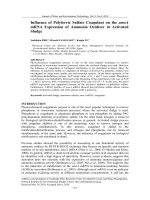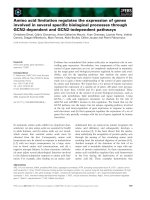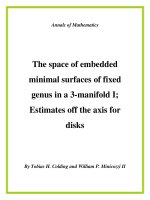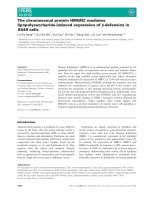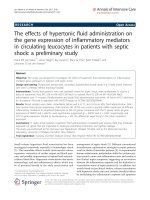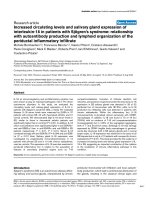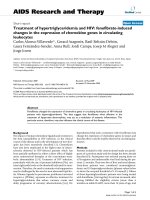The Accounting Expression Of Fixed Assets In The Cr And Russia
Bạn đang xem bản rút gọn của tài liệu. Xem và tải ngay bản đầy đủ của tài liệu tại đây (872.51 KB, 90 trang )
Ma sa r yk u n iv e rsi t y
Faculty of Economics and Administration
Branch of study: Finance
THE ACCOUNTING EXPRESSION OF FIXED
ASSETS
IN THE CR AND RUSSIA
Účetní zobrazení dlouhodobého
majetku v ČR a Rusku
Diploma thesis
Supervisor:
Ing. Ladislav ŠIŠKA, Ph.D.
Author:
Mark LITVINOV
Brno, April 2012
Masarykova univerzita
Ekonomicko-správní fakulta
Katedra financí
Akademický rok 2011/2012
ZADÁNÍ DIPLOMOVÉ PRÁCE
Pro:
LITVINOV Mark
Obor:
Finance
Název tématu:
ÚČETNÍ ZOBRAZENÍ DLOUHODOBÉHO MAJETKU V
ČR A RUSKU
The accounting expression of fixed assets in the CR and
Russia
Zásady pro vypracování:
Cíl práce:
Porovnat způsoby účetního zobrazení dlouhodobého majetku v ČR a Rusku a na základě této
komparace vyhodnotit pozitiva a negativa obou účetních systémů, vč. otázky věrohodnosti
vyjádření fyzického a morálního opotřebení majetku.
Postup práce a použité metody:
Teoretická část práce rozebere způsoby zobrazení dlouhodobého majetku v ČR a Rusku.
Konkrétně budou porovnány především způsoby vymezení dlouhodobého majetku, složky
jeho pořizovací ceny a způsoby odepisování, které vyjadřuje dlouhodobý pokles hodnoty
dlouhodobého majetku v důsledku fyzického opotřebení, ale i morálního zastarání. Stranou
pozornosti nezůstane ani vliv vyššího vytížení majetku na pozitivní výsledky hospodaření v
důsledku lepšího roznesení fixních nákladů, které jsou s ním spojeny, do většího objemu
výkonů.
V praktické části práce bude představen konkrétní ruský podnik a jeho výrobní program.
Následně se pozornost upře na strukturu dlouhodobého majetku v daném podniku, způsob
jeho zobrazení v účetnictví, na výpočet jeho zůstatkové ceny a úroveň vytížení majetku ve
sledovaném období. V závěru budou diskutovány rozdíly, které by se vyskytly, pokud by
analyzovaný podnik vykazoval stejná aktiva podle českých účetních předpisů. Diskutována
bude i otázka použití reprodukčních cen pro vyjádření hodnoty dlouhodobého majetku.
V práci se uplatní zejména obecně vědní metody analýzy, syntézy a komparace. K získání
informací pro zpracování praktické části budou využity účetní směrnice a data, dále
rozhovory s pracovníky finančního útvaru konkrétního podniku.
Rozsah grafických prací:
dle pokynů vedoucího práce
Rozsah práce bez příloh:
60 – 80 stran
Seznam odborné literatury:
SLÁDKOVÁ, EVA. Finanční účetnictví a výkaznictví. Vyd. 1. Praha: ASPI, 2009. 451 s.
ISBN 978-80-7357-434.
PRUDKÝ, PAVEL - LOŠŤÁK, MILAN. Hmotný a nehmotný majetek v praxi :komentář,
příklady, výklad změn. 12. aktualizované vyd. Olomouc: Anag, 2010. 279 s.
ISBN 9788072635962.
VALOUCH, PETR. Účetní a daňové odpisy 2011. 6. vyd. Praha: GRADA Publishing, a.s.,
2011. 140 s. Účetnictví a daně. ISBN 978-80-247-3803-1.
Účetní předpisy pro podnikatele: (zákon o účetnictví, prováděcí vyhláška k zákonu, České
účetní standardy): komentář. Edited by Libuše Müllerová - Hana Vomáčková - Dana
Dvořáková. 3., aktualiz. vyd. Praha : ASPI, 2009. xvi, 585 s. ISBN 978-80-7357-435.
BŘEZINOVÁ, HANA - ŠTOHL, PAVEL. Účetní závěrka: výklad a praktické příklady: pro
studenty vysokých škol s ekonomickým zaměřením. 2. aktualiz. vyd. Znojmo: Soukromá
vysoká škola ekonomická Znojmo, 2010. 136 s. ISBN 9788087314074.
Vedoucí diplomové práce:
Ing. Ladislav Šiška, Ph.D.
Datum zadání diplomové práce:
4. 3. 2011
Termín odevzdání diplomové práce a vložení do IS je uveden v platném harmonogramu
akademického roku.
……………………………………
vedoucí katedry
V Brně dne 4. 3. 2011
…………………………………………
děkan
J mén o a p ří j men í a u tora:
Název d i p l omov é p ráce:
Název p rác e v an gl i čti n ě:
Kated ra :
Ved ou cí d i p l omové p ráce:
Rok ob h ajob y:
Mark Litvinov
Účetní zobrazení dlouhodobého majetku v ČR a
Rusku
The accounting expression of fixed assets in the
CR and Russia
Katedra financí
Ing. Ladislav Šiška, Ph.D.
2012
Anotace
V podmínkách globální ekonomické recese je velmi důležité využití stálých aktiv podniku.
Stálá aktiva, jako hlavní nástroj výrobního procesu, umožňují jakékoli organizaci stát se
produktivnější a ziskovější. Většina aspektů podnikové činnosti a jejího řízení je s nimi úzce spojena.
Diplomová práce se zabývá analýzou efektivity využití stálých aktiv na příkladu ruské akciové
spolenosti “Koncern Izhmash” Tato společnost je jedním z největších ruských výrobců sportovních,
loveckých stejně jako bojových zbraní. Zahrnuto je i srovnání účetního systému České republiky a
Ruska.
Annotation
Under conditions of the global economic recession, fixed assets utilization efficiency increase
is of great importance. Fixed assets while being the major part of production process, allow any
organization to become more productive and profitable. Most aspects of enterprise activity and
management are closely connected with them. The diploma thesis deals with an analysis of fixed
assets utilization efficiency through the example of the Russian joint stock company “Concern
Izhmash”. This company is one of the biggest Russian producers of sports and hunting as well as
combat weapons. The comparison of the Czech Republic and Russian accounting systems is also
included.
Klíčová slova
Analýza dlouhodobých aktiv, srovnání účetních systémů, využití zařízení, ocenění
dlouhodobých aktiv, odpisy dlouhodobých aktiv
Keywords
Fixed assets analysis, comparison of the accounting systems, the utilization of the
equipment, fixed assets evaluation, depreciation of fixed assets
Prohlášení
Prohlašuji, že jsem diplomovou práci Účetní zobrazení dlouhodobého majetku v ČR a
Rusku vypracoval samostatně pod vedením Ing. Ladislava Šišky, Ph.D. a uvedl v ní všechny
použité literární a jiné odborné zdroje v souladu s právními předpisy, vnitřními předpisy
Masarykovy univerzity a vnitřními akty řízení Masarykovy univerzity a Ekonomicko-správní
fakulty MU.
V Brně dne 26. dubna 2012
vlastnoruční podpis autora
Poděkování
Na tomto místě bych rád poděkoval Ing. Ladislavu Šiškovi, Ph.D. za cenné připomínky a
odborné rady, kterými přispěl k vypracování této diplomové práce stejně tak jako za čas, který
mi věnoval. Dále bych rád podekoval své rodine za morální a materiální podporu, které se mi
dostávalo po celý prubeh mého studia.
Contents
Introduction……………………………………………………………………………………12
1 Fixed assets reflection in the Russian Federation and the Czech Republic: complex
specification of the accounting systems………………………………………………………………..15
1.1 The specification of fixed assets…………………………………………………………..15
1.2 Fixed assets accounting system of the Russian Federation……………………………….17
1.2.1 The statutory regulation and objectives of fixed assets accounting……………………..17
1.2.2 The classification of fixed assets………………………………………………………..18
1.2.3 Fixed assets accounting……………...…………………………………………………..22
1.2.4 Depreciation of fixed assets……………………………………………………………..25
1.2.5 Fixed assets analysis…………………………………………………………………….27
1.2.6 Fixed assets utilization efficiency upgrading ways……………………………………..30
1.3 Fixed assets accounting system of the Czech Republic………………………………...…32
1.3.1 The importance of IFRS for comparison of the accounting systems of the Russian
Federation and the Czech Republic……………………………………………………………………32
1.3.2 The statutory regulation…………………………………………………………………33
1.3.3 Determining the long-term tangible assets…………………………………………...…33
1.3.4 Determining the long-term intangible assets…………………………………………....36
1.3.5 The evaluation of the long-term tangible and intangible assets………………………...37
1.3.6 The depreciation of the long-term tangible and intangible assets………………………39
1.3.7 The disposal and discarding the long-term tangible and intangible assets……………...43
2 Fixed assets analysis at the concern “Izhmash”……………………………………………..46
2.1. Brief characteristic of the company……………………………………………………....46
2.1.1 Legal status and company profile…………………………………………………….....46
2.1.2 The organization management structure………………………………………………...48
2.1.3 The key indices of the company functioning……………………………………………50
2.2 The fixed assets technical condition analysis at the concern “Izhmash”………………….54
2.3 The equipment age composition at the concern “Izhmash”……………………………….58
2.4 The equipment usage analysis at the concern “Izhmash”………………………………....59
2.5 The fixed assets utilization efficiency at the concern “Izhmash”………………………....64
2.6 Return on fixed assets ratio analysis at the concern “Izhmash”…………………………..66
2.7 The Czech Republic and Russia accounting systems: similarities and differences,
beneficial and negative impacts………………………………………………..………………………68
Conclusion………………………………………………………………………………...…..74
List of references………………………………………………………………………………77
List of tables…………………………………………………………………………………...81
List of abbreviations…………………………………………………………………………..82
List of appendices……………………………………………………………………………..84
Introduction
One of the most important factors of output increase and further development of any enterprise
is the availability of fixed assets needed for the effective economic activities. However to solve these
problems it is necessary not only to provide an enterprise with these assets but increase their efficiency
as much as possible. Besides that proper assets accounting also encourages an enterprise to continue in
operation while being competitive on domestic and external market in the long-term period and avoid
many problems in the production process.
The relevance of the thesis is conditioned by all these facts. Besides comprehensive
comparative approach of accounting systems of the two countries – Russia and the Czech Republic –
is applied in the thesis. The significance of the research is also proved by insufficient level of
knowledge of several aspects of these problems. Moreover, there have been only a few works on
examining the accounting systems of Russia and the Czech Republic in comparison up to now. That is
why the thesis is seen as valuable and can be of great interest, also taking into account close economic
relations between these two countries.
There are also some outfields connected with techniques (procedures) of fixed assets
utilization analysis, as well as the systematization of carrying out the analysis, etc.
The problems of fixed assets analysis and accounting were carefully studied by the Russian
economists like Belousova S.V., Babaev Y.A., Kondrakov N.P., Yeleneva J.A., etc. If to speak about
the works by Czech scholars it is necessary to mention those written by Valouch P., Dvorakova D.,
Sladkova E., Prudky P.
The target of the research is “The Concern “Izhmash” Open Joint Stock Company” 1 which is
one of the biggest producers of small-arms weapon of Russia and produces over 95% of all Russian
combat long barrel guns. The research subject is the fixed assets of this enterprise.
The aim of the thesis is to compare the approaches to accounting of long-term assets in the
Czech Republic and Russia and thus evaluate beneficial and negative impacts on both accounting
systems, as well as to carry out the fixed assets analysis at the concern “Izhmash”.
The research tasks are determined by its aim. These are:
- to define fixed assets as an economic category;
- to give fixed assets classification and forms of their valuation (both in the Russian Federation
and the Czech Republic);
- to give assets accounting of the Czech Republic and Russia in comparison;
- to consider assets movement within the organization (acquisition, revaluation, exchange,
transactions with assets and their disposal).
1
Hereinafter: the concern “Izhmash”
12
- to offer the ways of fixed assets utilization efficiency improvement;
- to carry out the fixed assets analysis and particularly equipment utilization analysis.
The theoretical relevance of the thesis consists in the fixed assets analysis and accounting, as
well as their utilization efficiency. This analysis is carried out in relation to both accounting systems –
of the Czech Republic and Russia. Besides depreciation problems are considered and the summarizing
table containing distinctive features of accounting in these two countries is also made up.
The practical relevance of the research consists in the fact that the results of the study can be
of great help to more effective fixed assets utilization which finally results in the revenue increase of
the analyzed enterprise (as well as other organizations).
The novelty of the research consists in the fact that this work is one of the first attempts to
examine fixed assets accounting in the Russian Federation and the Czech Republic in comparison.
Besides the detailed analysis of fixed assets condition in dynamics at the concern “Izhmash” during
the period from 2007 to 2009 is given. It will help the organization to detect the existing problems
related to its unstable financial status as well as some others like partially obsolete equipment, etc. and
eliminate them.
The methodological foundation of the thesis comprises regulatory, legislation, special
literature as well as periodical on the problems of fixed assets analysis and accounting of both
countries – Russia and the Czech Republic.
Accounting practices and techniques of estimation as well as scientific analysis, synthesis and
comparison scientific methods are used in the research work. The information background of the
thesis comprises the works by Russian and foreign scholars on the problems of fixed assets and their
utilization as well as different sorts of data including the financial statements of the concern
“Izhmash” for the period from 2007 to 2009 and the data obtained from the staff of the company.
The thesis consists of the introduction, two chapters, the conclusion, list of references, list of
tables, list of abbreviations and a list of appendices.
In the first chapter the theoretical fundamentals of fixed assets accounting and analysis in the
Russian Federation and the Czech Republic, their classification as well as the ways of fixed assets
utilization efficiency upgrading are considered. Particularly, the ways determining assessment of
assets are given in comparison, as well as parts of its historical costs and depreciation methods, which
show a long-term assets decline because of their physical and technological obsolescence
The second chapter is focused on the structure and legal status of the specific Russian
enterprise – the concern “Izhmash” as well as the main types of activity and performance indices of
the enterprise. The structure of the enterprise long-term assets is examined as well as the way of its
accounting in the accounting system. The table comprising the similarities and differences between the
Czech Republic and Russian accounting systems is given. Besides that the influence on the concern
13
accounting is calculated in case this enterprise keeps accounting by using the Czech Republic
accounting principles presented in this table.
The appendices comprise different tables necessary for better understanding of the specific
nature of the concern “Izhmash” activities, particularly the productive possibilities of the company in
the medium-term period and its influence on fixed assets, as well as the average useful life of its
equipment and the reserves of the return on productive assets ratio increase. Further, the differences
between the accounting system of the Russian Federation and the IFRS system are represented there.
14
1 Fixed assets reflection in the Russian Federation and the
Czech Republic: complex specification of the accounting systems
1.1 The specification of fixed assets
Ineffective usage of resources is one of the main reasons for the economic crisis and rising
prices. Resources are means of production, all national resources which are owned by the government
and its administrative centres, as well as by companies, non-governmental organizations, households
and individuals. Resources are divided into material, human, financial and natural resources.
Means of production are cars, machine tools, instruments and equipment, buildings, facilities,
communication lines, means of transport, stocks, etc. All these kinds of resources are called
fixed capital or production funds.
Fixed assets (fixed capital, fixed funds) are mechanical facilities which are involved in the
production process while retaining their physical form. They are intended for needs of company’s core
activities and should have useful life for more than one year.2
Property, plant and equipment owned by the company and used in production process or for
supply of goods and services, as well as for performing managerial functions, belong to fixed assets.
The expected useful life of these assets exceeds one year (or operating cycle in case if it does not
exceed one year).
Fixed assets - property and machinery which a company owns and uses, but which the
company does not buy or sell as part of its regular trade including the company’s investments in shares
of other companies.3 Fixed assets – long-lived assets used to produce or sell products and services,
also called property, plant and equipment, or plant assets.4
Fixed capital is the capital in the form of buildings and machinery. Fixed assets make up a
large part of assets on most balance sheets, and they yield depreciation, often one of the largest
expenses on income statements. The acquisition or building of a fixed asset is often referred to as a
capital expenditure. Capital expenditures are often important events because they impact both a shortand a long-term success of a company. 5
2
Lugovoi V.A. The accounting of fixed assets, intangible assets and long-term investments. –
Moscow: FBK-PRESS, 2004, pp. 17-18 (author’s translation)
3
Collin S. Dictionary of Accounting. 3. edition. London: Bloomsbury, 2004. 222 p. ISBN 0747569916,
p.92
4
This term is usually used in the GAAP accounting
5
Wild J., Shaw K., Chiappetta B. Financial and Managerial Accounting: information for decisions. 3.
edition. Boston: McGraw – Hill/ Irwin, 2009. xxxii, 589, 698 p. ISBN 97800733605601113, p.322
15
Fixed assets are intangible, tangible and long-term financial assets. Intangible assets – assets
of an intangible nature with a term of usage longer than 1 year with a value exceeded a limit chosen by
an enterprise in according with so- called “common traditions”. As the “common traditions” the
amount of 60000 CZK is usually respected, but it is not obligatory given.6
These assets are long-term resources that benefit business operations, usually lack physical
form and have uncertain benefits, but controlled by the company. Their value comes from the
privileges and rights granted to or held by the owner. Valuable rights, copyright, franchises, licenses,
trademarks, patents, software, know-how, goodwill can be mentioned as the examples of intangible
assets.7
Assets of an intangible nature with a term of usage longer than 1 year but with a value which
do not come to a limit chosen by the enterprise are charged as costs immediately in the moment of
their acquirement. 8
Tangible assets - assets of a tangible nature with a term of usage longer than 1 year with a
value exceeded a limit chosen by an enterprise in according with so- called “common traditions” and
some other assets of a tangible nature (especially buildings and parcels) regardless to their value. In
this case the amount of 40000 CZK is usually respected as “common traditions”. This amount is not
obligatory given as well but from the tax point of view it is obligatory determined by the law of
income taxes.9 Examples of tangible assets – buildings, parcels, cars, hardware, equipment, machinery,
etc. 10
Long-term financial assets – assets of a financial nature with a term of payment longer than 1
year regardless to their value. As examples of long-term assets – long-term investments, capital shares,
long-term bills of exchange, etc. can be mentioned. 11
For many companies, fixed assets make up the single largest class of assets they own. Fixed
assets are set apart from all other assets of the company by two important features, which should be
regarded as a whole. First, fixed assets are used in operations. This makes them different from, for
instance, inventory that is held for the sale and not used in operations. The distinctive feature here is
use, not type of asset. The second important feature is that fixed assets have useful lives extending
6
Valouch P. Accounting. 1. edition. Brno: Mendel Agricultural and Forestry University, 2005. 102 p.
ISBN 8071579165, p.13
7
Valouch P. Accounting. 1. edition. Brno: Mendel Agricultural and Forestry University, 2005. 102 p.
ISBN 8071579165, p.13
8
Valouch P. Accounting. 1. edition. Brno: Mendel Agricultural and Forestry University, 2005. 102 p.
ISBN 8071579165, p.13
9
586/1992 Col., as subsequently amended. Hereinafter: the law of the income tax
10
Valouch P. Accounting. 1. edition. Brno: Mendel Agricultural and Forestry University, 2005. 102 p.
ISBN 8071579165, p.13
11
Valouch P. Accounting. 1. edition. Brno: Mendel Agricultural and Forestry University, 2005. 102 p.
ISBN 8071579165, p.13
16
over more than one accounting period. This makes fixed assets different from the current assets such
as supplies and inventories of the material that are normally consumed in the short period of time after
they are placed in use.12
Fixed assets of the enterprise form its material and technical basis. Increase in assets and their
upgrading result in high quality production and the increase of the company’s competitiveness.
1.2 Fixed assets accounting system of the Russian Federation
1.2.1 The statutory regulation and objectives of fixed assets accounting
The fixed asset’s accounting in the Russian Federation is regulated by following regulatory
documents:
1. Federal Act of 21 November 1996 no.129 – FA “On accounting” (as amended by FA of 6
December 2011 no.402 – FA);
2. The Order of the Ministry of Finance of the Russian Federation “The approval of
the Russian Accounting Standard13 concerning financial accounting and accounting reports”;
3. The Order of the Ministry of Finance of the Russian Federation “The approval of the RAS
concerning fixed asset’s accounting no. 6/01”;
4. The Order of the Ministry of Finance of the Russian Federation “The approval of
Methodological Instructive Regulations for fixed assets accounting in the Russian Federation”;
5. The Order of the Ministry of Finance of the Russian Federation “The approval of the
enterprises forms of accounting reports”.
Russian Accounting Principles (RAP)14 is the term used to indicate the whole body of Russian
regulatory documents governing accounting and reporting. Official documents regulating, directly or
indirectly, accounting and reporting in Russian are designed for use by all entities. However, there are
additional specific regulations for non-profit entities.
The main objectives of the fixed assets accounting are:
1. correct document execution and up to date recording of the asset acquisition in the
bookkeeping entry, as well as its movement and disposal;
2. reliable determination of the fixed assets sales and disposal results;
3. complete assessment of costs related to fixed asset’s maintenance (expenses for check-up,
maintenance, and all kinds of repairs);
12
Wild J., Shaw K., Chiappetta B. Financial and Managerial Accounting: information for decisions. 3.
edition. Boston: McGraw – Hill/ Irwin, 2009. xxxii, 589, 698 p. ISBN 97800733605601113, p.322
13
Hereinafter RAS
14
The same term as RAS
17
4. control of the safety of fixed assets and their productivity.15
The distinctive feature of the fixed assets is that they are recoverable in the production process
and retain their original form for a long period of time. Due to the production process and environment
they gradually depreciate and transmit their initial cost on production expenditures during its useful
life by depreciation charge at the established standard.
The structure of fixed assets is formed of the correlation of its inner parts. The movement of
fixed assets is an acquisition, disposal, depreciation, change, increase or decrease of the funds. The
technical level of the production largely depends on the structural changes of fixed assets. That’s why
the analysis of fixed assets structure and the movement of basic capital shall be regarded as a whole. 16
1.2.2 The classification of fixed assets
Fixed assets classification is necessary for their definition, composition as well as their
accounting. In the Russian Federation there is a single classification of fixed assets according to which
they belong to different economy branches; they are also divided according to their functioning;
natural and material composition; the level of their usage; and their being in possession (i.e. the right
for them).17 Subject to different kinds of activities fixed assets belong to some certain
branches (industry, agriculture, transport, construction, trade, public catering, telecommunication,
material and technical security, etc.) In terms of their functions fixed assets are divided into production
and nonproduction assets.18 The latter ones do not participate in the manufacturing process. These are:
dwelling houses, clubs, stadiums, hospitals, etc. Inspite of the fact nonproduction assets don’t affect
the volume of production, the increase in labour productivity as well as nonproduction fund expansion
are closely connected with material welfare of the enterprise workers which finally influences the
output of the enterprise on the whole.
Each enterprise has fixed and circulating (current) funds. They both form so-called production
funds. They participate in production process or providing services. Different sorts of machines,
instruments and tools belong to production funds.
In their turn, fixed assets are those involved in production process, such as various machinery
and equipment, tools as well as buildings, facilities and others.
15
Russian Accounting Standards “Accounting of Fixed assets” 6/01, approved by Order of Ministry of
Finance of the Russian Federation of 30 March 2001, no. 26n (as amended by Ministry of Finance Order of 18
May 2002)
16
Kondrakov N.P. Accounting. – Moscow: Projekt- N., 2008, pp. 14-15 (author’s translation)
17
Babayev Y.A. Accounting. Manual for students of Higher Educational Establishments – Moscow:
UNITY-DANA, 2007, p. 36 (author’s translation)
18
Kondrakov N.P. Accounting. – Moscow: Projekt- N., 2008, p. 16 (author’s translation)
18
The optimum ratio is obtained when the proportion of nonproduction assets amounts to 2030% of aggregate value of fixed assets. 19
In accordance with the accounting system of the Russian Federation and particularly its article
RAS no. 6/01, there are the following groups of fixed assets:
- buildings (workshops, warehouses, testing laboratories, etc.);
- facilities (construction engineering facilities, like trestles, roads, bridges, tunnels and others);
- intra-organisational roads;
- transfer units (power supply network, heat distribution network and gas distribution
network);
- machinery and facilities; including:
1) load-carrying vehicles and facilities (electric generators, electric motors, steam engines,
turbines, etc.)
2) working machines and facilities (machine tools, molding machines, electric furnaces, etc.)
3) measuring devices and control apparatus and devices, laboratory test facilities;
4) computing machinery;
5) automatic machines and facilities, different lines (automatic machine tools, automatic
assembly lines);
6) other machinery and facilities:
- means of transport (goods wagons, cars, lift trucks, trolleys);
- instruments and tools (cutting tools, spinning tools, fitting tools, assembling tools);
- production implements and furnishings (containers, pallets, desks, etc.)
- organizational stock;
- agricultural enterprise (productive and breeding livestock);
- decorative perennial plantings;
- other fixed assets (library stock, museum pieces, etc).20
Speaking about fixed assets it is also necessary to mention capital investments into land
reclamation (irrigation, drainage and others); capital investments into leased items of fixed assets; land
plots and environmental facilities (water, mineral resources and other natural resources).
To declare a facility a fixed asset it is necessary to fulfill the following stipulations:
-the facility is intended for exploitation in the production process, execution of work or
rendering services as well as for various management needs e.g. to let the facility into tenure or
temporary possession for a fee;
-the facility is intended for long-term exploitation, above 12 months or normal operating
cycle providing it exceeds 12 months;
-the organization does not intend to resell the facility in the future;
19
Kondrakov N.P. Accounting. – Moscow: Projekt- N., 2008, p.18 (author’s translation)
Russian Accounting Standards “Accounting of Fixed assets” 6/01, approved by Order of Ministry of
Finance of the Russian Federation of 30 March 2001, no. 26n (as amended by Ministry of Finance Order of 18
May 2002)
20
19
-the facility can bring a return in the future.21
Fixed assets priced at the minimum threshold in accordance with accounting policies but not
exceeding 40000 roubles (1000 euros, 25000 CZK22) per item, are recorded in accountancy
and accounting reports within inventories. In order to preserve production facilities while exploiting
them the movement control system is needed.
The following assets though not being fixed are considered as circulating ones: with less than
12 months of exploitation regardless of their cost:
- fishing gear;
- purpose-made tools;
- special uniform;
- temporary facilities;
- items for leasing;
- bedding items;
- young and experimental animals;
- perennial plantings in nurseries.23
The facilities comprise some special buildings and constructions for auxiliary production (i.e.
managerial, administrative and mechanical facilities, stockrooms, warehouses, etc.)
Speaking of facilities it is also necessary to mention construction engineering facilities, mining
works (shafts, adits, cross-cuts), oil and gas wells, waste treatment facilities, tunnels and bridges.
Transmissive units comprise electric power lines, cable lines, phone network, telegraph
network, transmission system, radio communication, pipe lines, air pipe-lines, etc.
Electric generators and engines (direct current motors and alternating current motors) belong
to load-carrying vehicles. Here there are also current converters, mercury-arc converters, transformers,
steam boilers, compressor systems, etc.
Working machines and plant equipment involve various pieces of equipment used in the
production process, i.e. pressing tools, rolling mills, lift trucks, fan systems, excavators, lifting
apparatus, etc. Here are also various computer machines and control devices.
All kinds of moveable vehicles (railway, automobile transport as well as truck vans, electric
cars, motortrucks, lift trucks, railway engines, etc. belong to means of transport.
21
Sokolov Y.V. Theory of Accounting: Peculiarities. – Moscow: Projekt- N., 2007, p.31 (author’s
translation)
22
1 euro equals 40 Russian roubles and 25 CZK
Russian Accounting Standards “Accounting of Fixed assets” 6/01, approved by Order of Ministry of
Finance of the Russian Federation of 30 March 2001, no. 26n (as amended by Ministry of Finance Order of 18
May 2002)
23
20
All kinds of mechanized and non-mechanized manual implements and devices fastened to
machinery like electric welding machine, mechanical arms, hammer drills, clamps, chucks, etc. belong
to machine tools.
Production and organizational stocks comprise different items for production purpose (work
tables, file tables and job safety equipment). Technical libraries as well as fire fighting equipment, etc.
also belong to the rest of fixed assets.24
The importance of each of fixed assets groups in the production process and the increase in its
efficiency is different. Those directly affecting the level of mechanization fixed assets are working
machines, equipment, means of transport and instruments of production. Their technical quality as
well as their degree of utilization greatly affect the volume of production and its efficiency.
Other parts of fixed assets (e.g. transmissive facilities) participate in the production process
indirectly as they create necessary conditions for it. The level of the material and technical facilities of
the plant depend largely on both quality and quantity of fixed assets in use.
The ratio between global value of fixed assets and the value of some separate groups of fixed
assets determine its structure. Each enterprise has its own structure of fixed assets reflecting their
production and technical specific features.25
Besides above mentioned groups of assets, there are also fixed assets in operation owned by
the organization (which include also fixed assets standing ready for use; under repair; fixed assets for
the substitution of the overage equipment; as well as fixed assets at the stage of completion;
reconstruction and partial dismantling); laid-up fixed assets and off-duty fixed assets (excessive and
incomplete equipment which is not used in the production process for the different reasons). Such
stratification of assets is resulted in getting information about fixed assets productivity and efficiency
of its usage as well as the replacement of worn-out equipment and the correct calculation of fixed
assets depreciation in order to include it in the operation expenses.
There is another classification of fixed assets according to which fixed assets are divided as
fixed assets owned by the company under the right of ownership (including those which are leased
out); fixed assets under management and operating control of the organization; fixed assets taken on
lease.26
24
Russian Accounting Standards “Accounting of Fixed assets” 6/01, approved by Order of Ministry of
Finance of the Russian Federation of 30 March 2001, no. 26n (as amended by Ministry of Finance Order of 18
May 2002)
25
Yeleneva Y.A. Economics of machine-building. – Moscow: Finance and Statistics, 2007, p.34
(author’s translation)
26
Lugovoi V.A. The accounting of fixed assets, intangible assets and long-term investments. –
Moscow: FBK-PRESS, 2004, p.29 (author’s translation)
21
1.2.3 Fixed assets accounting
Fixed assets have their original (acquisition, historical) cost, depreciation value
and replacement (present) cost. They are defined in real terms and in terms of money. Each operation
of their movement must be executed through fixed basic source documents according to the list of
unified document forms of primary accounting documentation of the State Committee of Statistics of
the Russian Federation of 21.01.2003 no. 7.
Asset acquisition to the enterprise means their coming into operation and capitalization of
assets. Fixed assets are mainly formed due to the completion of construction and assembling
operations; their purchase, non-repayable receipts; acquisition as contribution to the equity capital;
transfer of ownership on completion of leasing period (provided this transfer of ownership is not
stipulated by the agreement); identifying unaccounted fixed assets facilities based on the results
of inventory accounting; assets acquisition from government or municipal agencies in case of unitary
system.
Business accounting fixed assets unit is an inventory item. Fixed assets inventory item is an
item with all its fittings or devices or a separate facility intended for some specific purpose or a
complex of items representing an aggregate unit. In other words, this inventory unit usually performs
one and the same specific function.27
Fixed assets are included for accounting purposes at their acquisition cost. The latter (the
historical cost) is determined by summing up actual purchase costs, construction costs except for the
value added tax and other compensated taxes. The mentioned costs are:
- sums of money paid according to contract made with supplier or seller as well as sums of
money paid for delivery of item;
- sums of money paid to organizations for information and consulting services connected with
assets acquisition;
- customs duties;
- sums of money paid to organizations for the contract for construction work;
- non-recoverable taxes, state duty paid due to the fact of item acquisition;
- some brokerage fee for assets item acquisition;
- other costs connected with assets acquisition, construction, etc.
General business expenses and some other expenses are not included into actual purchase
costs or expenditures for item construction (unless they are directly connected with acquisition or
construction of assets).28
27
Explanatory Dictionary of Accountant / edited by Shapovalova N.N., Prudnikov V.M.- Moscow:
INFRA-M, 2008 (author’s translation)
28
Russian Accounting Standards “Accounting of Fixed assets” 6/01, approved by Order of Ministry of
Finance of the Russian Federation of 30 March 2001, no. 26n (as amended by Ministry of Finance Order of 18
May 2002)
22
Original cost of fixed assets contributed to the authorized capital (charter capital) of the
organization is considered to be their monetary valuation, approved by the founders of the
organization (within the legislation of the Russian federation).
Original cost of fixed assets obtained by the organization through gift contract (gratis, free of
charge) is considered to be their current market value dated the entry of accounting purpose as
investments into fixed assets.
Original cost of fixed assets obtained by the contract providing fulfillment of obligations
through non-monetary assets is a value of assets delivered by organization. Value of these assets is
defined on the basis of the price, which is paid by the organization in comparable circumstances.29
Fixed assets owned by two or more organizations, are reflected by each of the organizations in
a possessed share. The account no.01 “Fixed assets”30 is used by the companies in the bookkeeping
entry.
Valuation of the same kinds of fixed assets which are built and acquired in different periods of
time could have unlike original costs. First of all it depends on the changes of equipment prices and
the costs of installation and construction works because of the technical progress. This makes difficult
to determine the real efficiency of fixed assets usage in the different enterprises of the same branches,
as well as to compare the profitability and evaluation of its evolution. The cost of the fixed assets
which is recorded in the bookkeeping entry is not liable to variation except as otherwise specifically
provided for by the laws of the Russian Federation.31 The change in the cost of fixed assets is possible
in cases of modernization, completion; reconstruction, technical upgrading, partial dismantling and
revaluation of the fixed assets.32
Modernization presupposes works caused by the change of technological and supporting
purpose of the depreciated fixed assets, as well as increased load and other acquired qualities.
Reconstruction is the process of items modification related to the production process
improvement and the increase in its technical and economic performance. This modification is carried
out within the framework of the project of the reconstruction with the aim of capacity increase, quality
improvement and shifts in products mix.
29
Russian Accounting Standards “Accounting of Fixed assets” 6/01, approved by Order of Ministry of
Finance of the Russian Federation of 30 March 2001, no. 26n (as amended by Ministry of Finance Order of 18
May 2002
30
Chart of Account of Finance and Economic Activities of the Organization and Instructions for Its
Use, approved by Order of Finance Ministry of the Russian Federation of 31 October 2000, no. 94n
31
Russian Accounting Standards “Accounting of Fixed assets” 6/01, approved by Order of Ministry of
Finance of the Russian Federation of 30 March 2001, no. 26n (as amended by Ministry of Finance Order of 18
May 2002)
32
Accounting: Manual for students of Higher Educational Establishments / edited by Bezrukikh P.S., Moscow : Accounting, 2008, p.55 (author’s translation)
23
The technical upgrading (or re-equipment) is a package of measures taken to increase the
technical and economic indicators on the basis of high-technologies implementation, mechanization
and automation of production, modernization and replacement of obsolete and worn-out equipment for
more productive one.33
On completion of fixed assets construction works, their full equipping or reconstruction, costs
accounted for the investments into fixed assets either increase initial costs of the fixed asset and are
written off the financial account or pass to a special account of fixed assets. Thus, fixed assets
reconstruction costs are not included into prime cost but are related to their initial cost increase. Their
initial cost can increase as a result of reconstruction at the expense of capital investments or decrease
at the expense of their partial dismantling or price reduction.
Commercial organization can revalue homogeneous items of fixed assets at current cost no
more than once a year. Revaluation is periodical clarifying replacement cost of fixed assets to bring
them into compliance with the market prices level. Revaluation is conducted by recalculation of its
acquisition or replacement cost and the accumulated depreciation during the period of the item
utilization. 34
Replacement cost is fixed assets reproduction expenditures. In other words, it is a sum of
money paid at current market prices in case of the item replacement for a new one. Within the
government act to determine an item current cost it is necessary to specify its acquisition cost through
its revaluation.
Fixed assets revaluation in terms of replacement cost is made annually as on 1st January. In
the current accounting fixed assets are reflected according to their acquisition cost and those
revaluated according to the residual cost. The results of this fixed assets revaluation as on the 1st
January of the current year are reflected in special accounting. They are not included into accounting
records of the previous reporting year and placed on the balance sheet at the beginning of the reporting
year. Fixed assets revaluation surplus as a result of this revaluation is recorded to the added capital.
Decreases in the value of assets as a result of the revaluation are placed on the uncovered loss account.
Fixed assets revaluation surplus equal to decreases in the value of assets conducted in the
previous periods of time and placed on the uncovered loss account is entered to an uncovered loss
account. Decreases in the value of assets are entered to the reduction of added capital funded with the
item revaluation surplus conducted in the previous reporting years. The excess of the decreases of the
value of the item over its revaluation surplus placed on the organization added capital as a result of
revaluation enters to uncovered loss account. And this should be disclosed in the financial statements.
33
Federal Act of 21 November 1996 no.129 – FA “On accounting” (as amended by FA of 6 December
2011 no.402 – FA)
34
Kondrakov N.P. Accounting. – Moscow: Projekt- N., 2008, p.40 (author’s translation)
24
In case of retirement of the item its revaluation surplus is transferred from organization added capital
to the uncovered loss account.35
1.2.4 Depreciation of fixed assets
All fixed assets except for land are subjected to physical deterioration and obsolescence, i.e.
when affected by physical forces as well as economic and technology factors they gradually lose their
properties and become unfit for use. Physical deterioration can be restored by repair or upgrading
capital assets but finally they are becoming unfit for use. In fact physical deterioration takes place both
while their being operated and during their non-operating. Partial physical deterioration can be
returned through repair and full –by replacement by new capital assets. Obsolescence appears when
capital assets in their design, efficiency and operating costs are behind advanced constructions but
what’s more important they are not able to produce high-quality production in the volume you can get
using advanced equipment. It needs the replacement of obsolete items by more advanced ones.36
Depreciation value – acquisition (replacement) costs minus accumulated depreciation. The
sources for acquisition of new assets can be received from the sales of the company’s production.
Partial redemption of the fixed assets value is included in the final price of the production.
Depreciation is the process of gradual transfer of fixed assets value to the final products and
the accumulation of the cash fund for the replacement of obsolete assets. Balance depreciation is
carried out regardless of the operation profit of the company in the accounting period. There are
following depreciation methods in the accounting in the Russian Federation:
1. straight-line method;
2. declining-balance method;
3. units-of-production depreciation;
4. sum of the year digits method.37
The straight-line method is used to calculate the fixed assets depreciation by the following
formula:
DA = Acquisition costs (reproduction costs) * depreciation rate
(1.1),
where: DA – the depreciation yearly amount.
The depreciation rate is calculated according to the formula:
35
Russian Accounting Standards on the Accounting Record-Keeping and Financial Statements in the
Russian Federation, approved by Order of Ministry of Finance of the Russian Federation of 29 July 1998, no.
34n (as amended by Ministry of Finance Order of 26 March 2007)
36
Belousova S.V. Fixed assets depreciation. – Moscow: Finance and statistics, 2006, p. 34 (author’s
translation)
37
Russian Accounting Standards “Accounting of Fixed assets” 6/01, approved by Order of Ministry of
Finance of the Russian Federation of 30 March 2001, no. 26n (as amended by Ministry of Finance Order of 18
May 2002)
25
